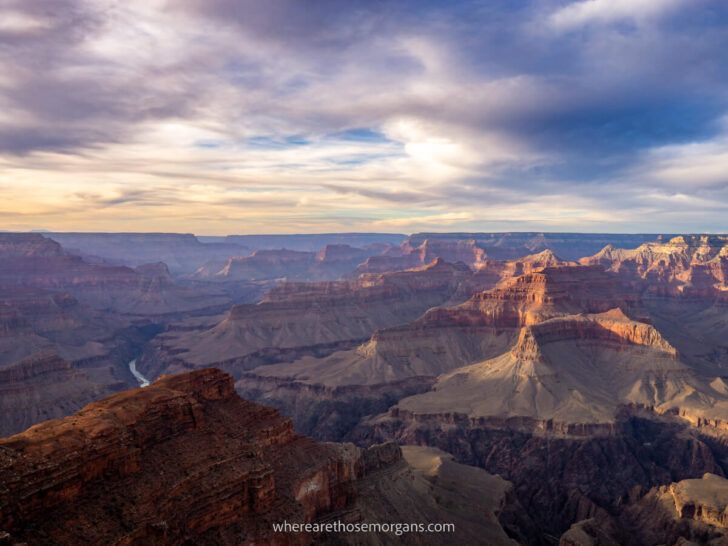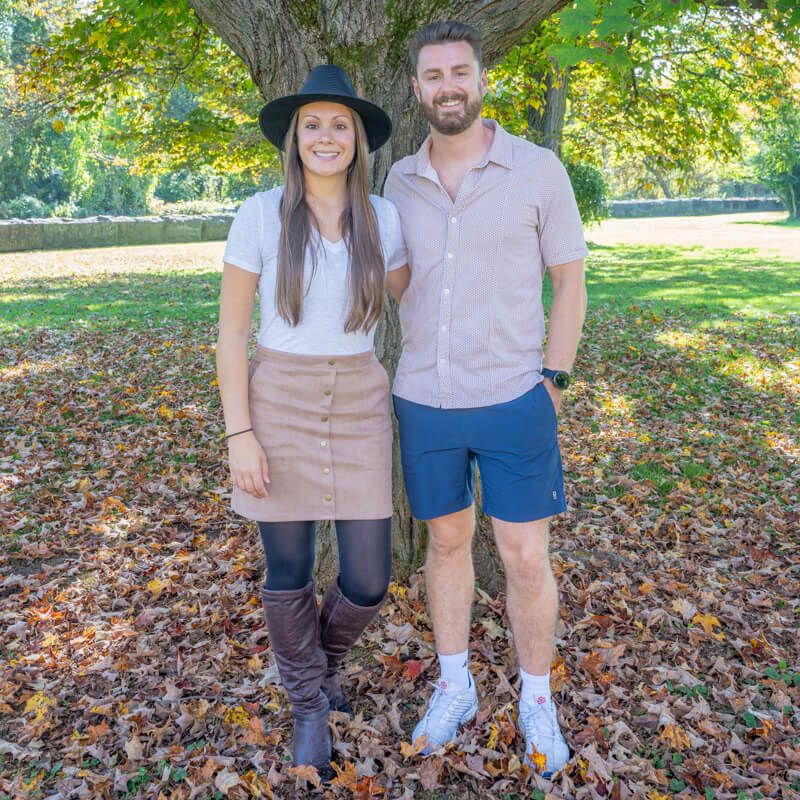Traveling the world allows you to see hundreds of truly incredible places, but only a handful are genuine ‘wow’ moments. The Grand Canyon is one of those jaw dropping photography locations you never forget. And it gets even better. Both sunrise and sunset transform the already magnificent Grand Canyon into a magical Grand Canyon.
We were left speechless in those final few steps approaching Grand Canyon South Rim for the first time. Then we saw a sunset, followed by a sunrise and our feelings of awe were blown into the stratosphere.
We’re going to explain everything you need to know about watching extraordinary sunrise and sunset events (they are events!) at Grand Canyon National Park South Rim in Arizona.
You will find the best sunrise and sunset locations, photography tips and much more.
Let’s shoot some incredible low light landscapes!
Best Sunrise and Sunset Locations Map
Our Grand Canyon Sunrise and Sunset locations map will be an essential tool you can use both before and during your trip to Grand Canyon South Rim.
Click into the map to zoom in and out so you can familiarize yourself with the geography of locations along South Rim. This will help you know exactly where to go when you arrive for sunrise and sunset.
Map key:
- Burgundy Stars – Each of the 4 best sunrise locations
- Orange Cameras – Each of the 4 best sunset locations
- Purple P – Where to park for sunrise options
- Blue Bus – Shuttle stop for sunset locations on Hermit Road
What To Expect For Grand Canyon Sunrise
Sunrise at the Grand Canyon is an unforgettable experience. Grand Canyon is one of the best national parks in the US and one of the most dramatic landscapes on the planet.
When the sun bursts out from an unimaginably flat horizon, a light show of reds, pinks, purples and browns begin to glow and contrast dramatically against deeper and darker canyon ravines.
And that’s just the rocks!
If you have clouds in the sky at sunrise, you can expect an array of beautiful oranges and pinks to compliment the deep blues and purples of civil twilight.
As you approach South Rim, the sun will rise to your right. You need to find a spot that opens up the Grand Canyon to your left so you can watch as majestic cliffs illuminate, but also where you can see the sun as it appears on the tabletop horizon.
Best Grand Canyon South Rim Sunrise Locations
You could turn up to any part of Grand Canyon South Rim in Arizona, look right and be blown away by the sunrise. Taking photographs of sunrise at the Grand Canyon is among the very best things to do in Arizona.
There are a number of sunrise spots on South Rim that would probably be just as amazing as the ones we will discuss below, but you would need to spend a week at the Grand Canyon to try them all out.
If you drive East along Desert View Drive, you could watch sunrise from Moran Point, Lipan Point or Desert View Watchtower.
They would be perfect for looking back into the canyon at sunrise rather than looking at the sun.
However, we’re going to go into more detail about each of the most popular and easier to access viewpoints:
1. Mather Point – Best For Sunrise
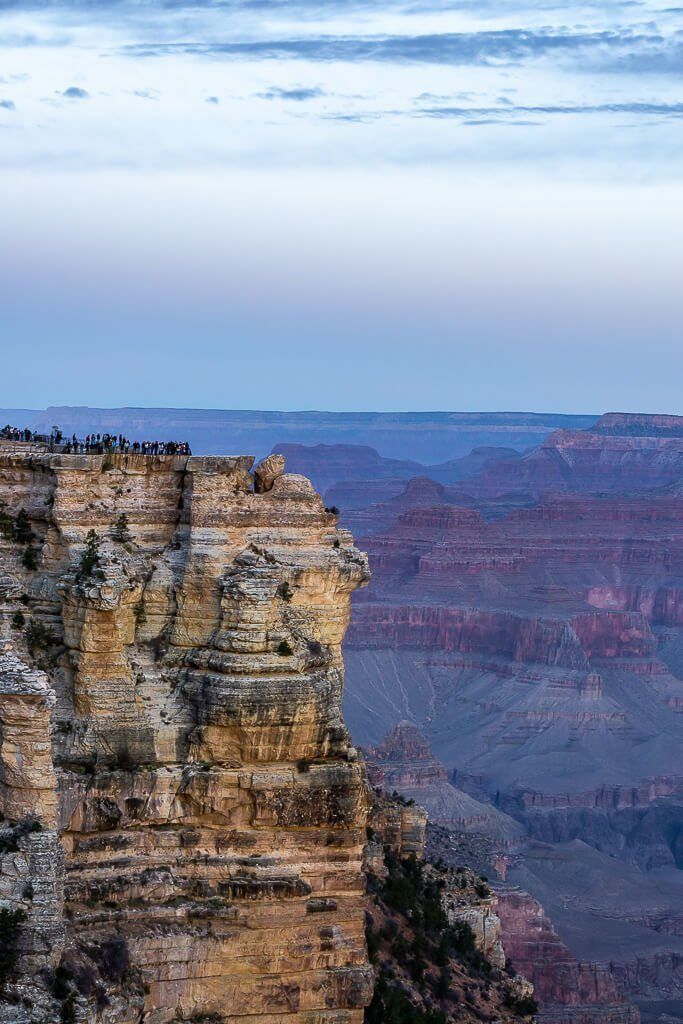
Mather Point is ‘the’ place to watch sunrise at Grand Canyon South Rim.
It is an outcrop of rock stretching out into the canyon with a fantastic vantage point for sunrise. You can easily see the sun rising to the East and watch as the canyon lights up to the West.
However, the problem with Mather Point is everyone knows it is ‘the’ place to watch sunrise and it is always packed full of sunrise seekers.
Now, that is only a problem is you prefer solitude at sunrise or you are a pro photographer who needs the space and no one in your shot.
If neither of these issues apply to you, Mather Point is the best place for you to watch sunrise at Grand Canyon South Rim.
It also happens to be the single easiest part of the entire national park to reach. Drive your car to the main visitor center right as you enter the park and walk less than 5 minutes to reach the Rim.
Look to your left and you will see a fenced outcrop, this is Mather Point.
Mather Point can become extremely crowded, particularly in Summer months. Thie photo above was taken in November on a freezing cold morning and it was still fairly busy.
We took this photograph from further East along the Rim, which is where we will show you the view both ways next as our top recommendation.
2. Along The Rim East Of Mather Point – Sunrise
If you’re looking for some peace and quiet to enjoy the sunrise or you’re a photographer who prefers to shoot without dozens (or hundreds!) of others around, we have the perfect solution for you.
When you reach the Rim, find Mather Point to your left side but ignore it. Turn right instead and walk along the Rim. You will notice a number of small openings and rocky paths leading to small outcrops.
Here are 3 images looking East at the sun and 3 looking West at the Canyon / Mather Point from our spot along the Rim:
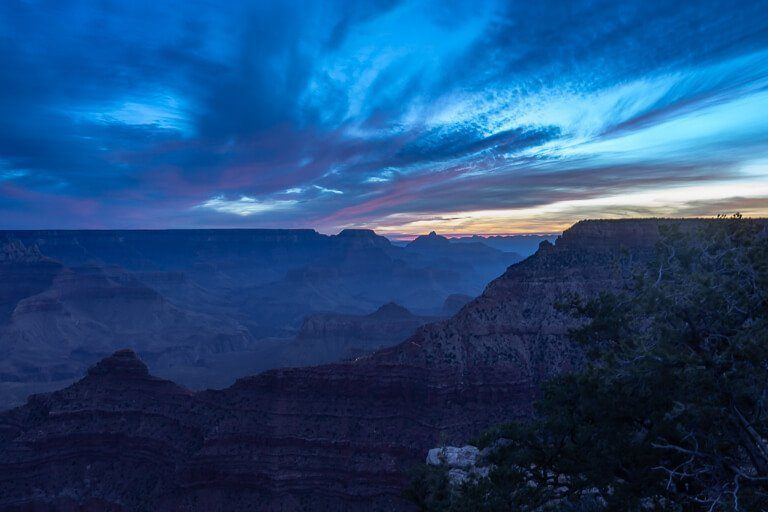
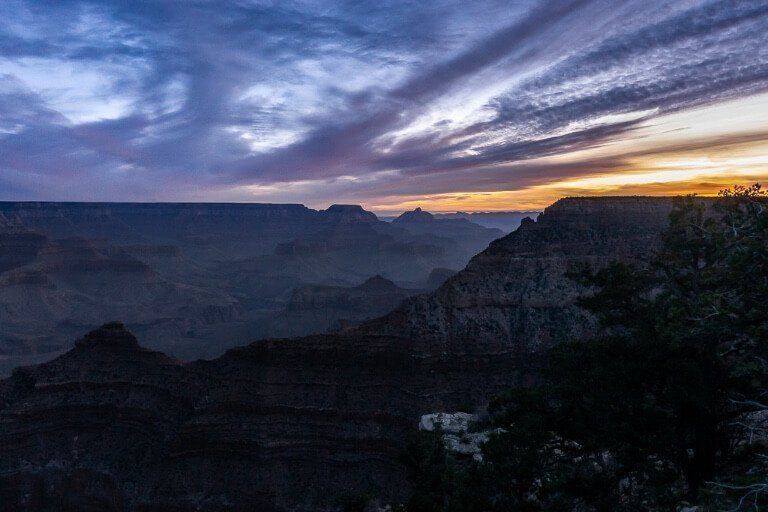
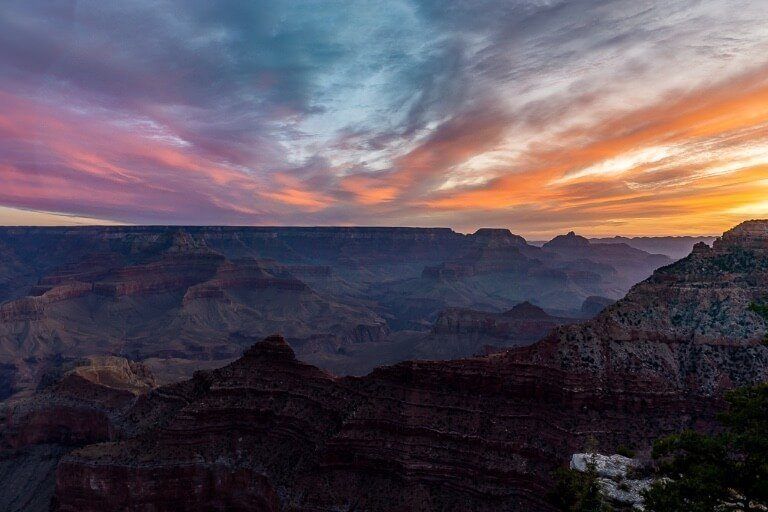
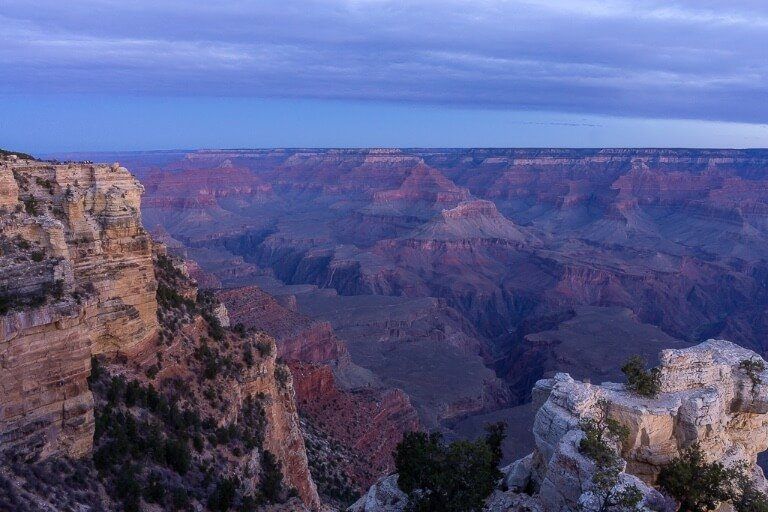
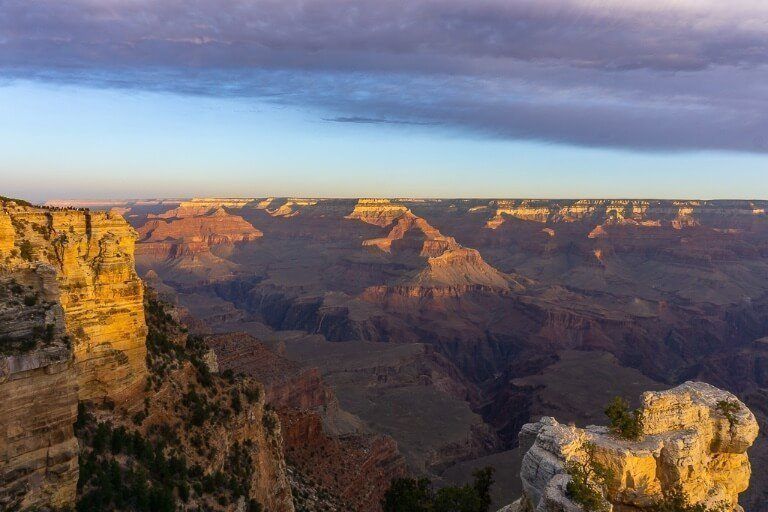
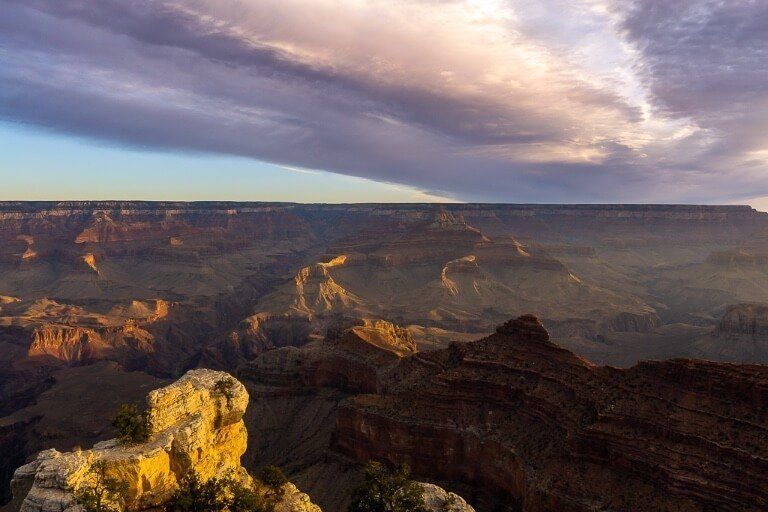
Sunrise from South Rim is one of the best we’ve ever seen.
If you arrive early enough, these secluded spots should be free and if not just keep walking toward the sun until you find one available.
Couples will find this far more romantic than Mather Point and photographers will be happy to avoid the crowds. Once settled in and wrapped up against some rocks, look over at how busy Mather Point becomes for sunrise.
This advice does come with a serious safety warning:
Please be careful when entering the small openings, many have sheer drops to the canyon floor and in the darkness before sunrise it will be difficult to see. Take high quality head torches and tread cautiously.
3. Yavapai Point – Sunrise
Yavapai Point is located 0.7 miles West of Mather Point and also bursts out into the canyon with a fenced off area. You can park your car in a parking lot right at the viewpoint and access the view quickly.
This viewpoint is more popular at sunset (mainly because fewer people like to wake up early) but it is also a great option for sunrise, particularly if Mather Point and the nearby Rim area are too busy.
This is a fenced off spur point, with far fewer options for finding a secluded area so we advise you arrive early to guarantee a prime spot with your tripod.
You have excellent views in both directions from Yavapai Point:
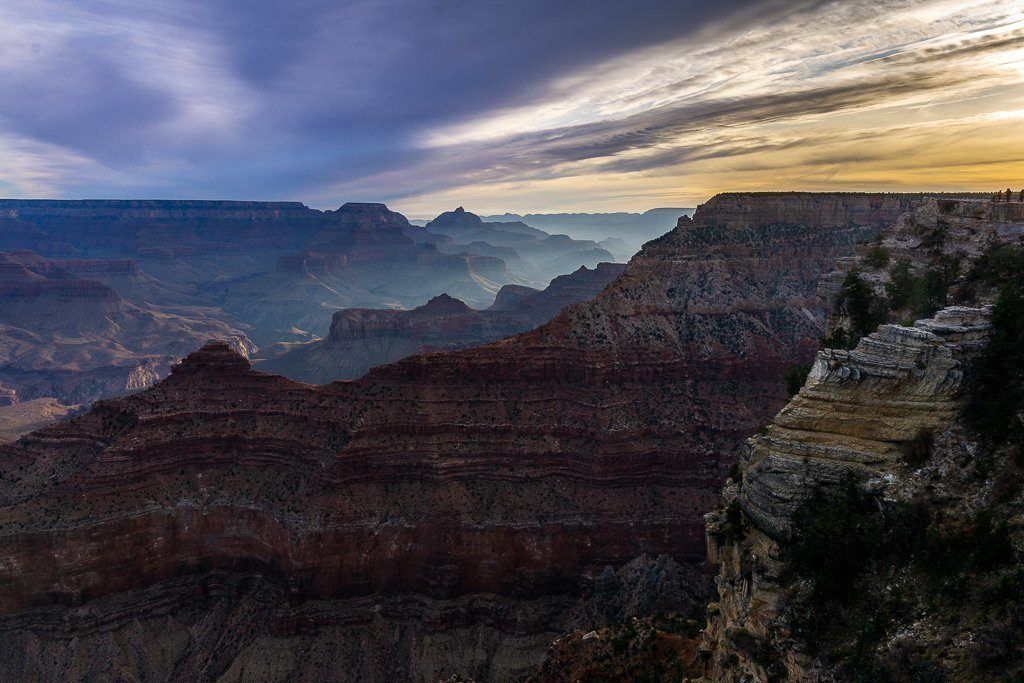
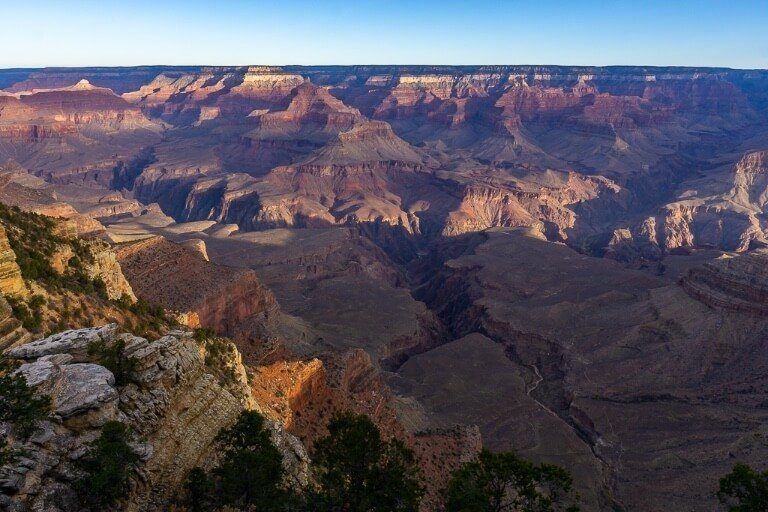
Right after sunrise, we quickly made our way from the secluded Rim spot near Mather Point, walked past Mather Point and continued until we reached Yavapai Point.
Sunrise was a little further on in its journey by the time we arrived but you can imagine what it would be like here from civil twilight onward.
As you can see, the landscape at Yavapai Point is stunning and a fantastic option for sunrise.
4. Yaki Point – Sunrise
Yaki Point is a fantastic viewpoint located near the famous South Kaibab Trail. It boasts far reaching views to the East and West, coupled with some of the most interesting canyon formations below.
We haven’t watched the sunrise at Yaki Point on either visit to Grand Canyon South Rim, but we have hiked South Kaibab to Bright Angel trail in one day. We started descending into the canyon right below Yaki Point before sunrise.
South Kaibab trail passes underneath Yaki Point and you get those same amazing canyon views from the trail as you would from Yaki Point up on the Rim.
Here’s the view to both the East and West from Yaki Point:
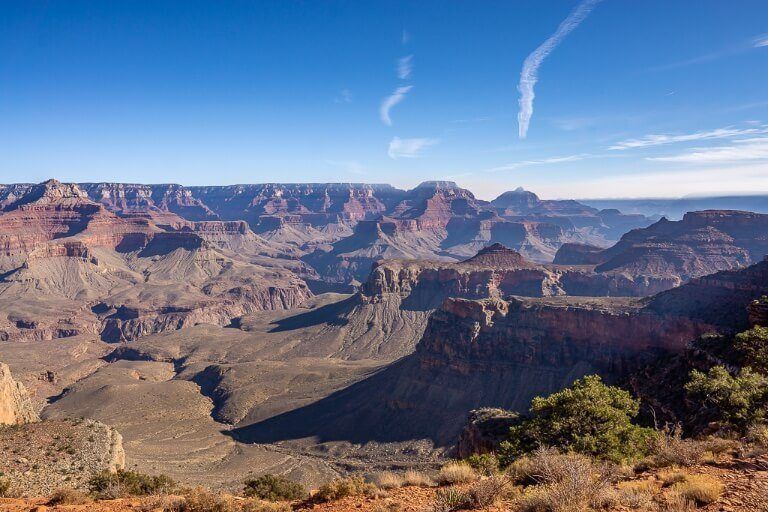
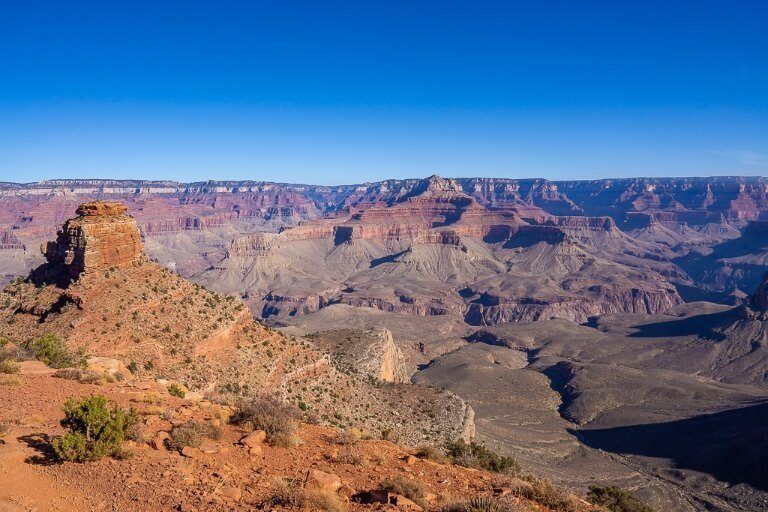
So looking down at South Kaibab hiking trail below and slightly to the left, you would see the sun rising over to your right hand side. This viewpoint would be much quieter than any of the others but would require a much earlier start.
The problem is getting to Yaki Point now that the road is closed to vehicles except the park shuttle. You can see more information about getting to Yaki Point in the sunrise planning section below.
Need help organizing your visit to Grand Canyon South Rim?
Our popular 30+ page Grand Canyon South Rim Guidebook can help you with planning every aspect of your trip.
Grand Canyon Sunset: What To Expect
Sunset at the Grand Canyon is equally as impressive as sunrise.
The major difference? Crowds.
Immense shadows are cast across vast canyon ravines as late afternoon turns into golden hour, creating an eerie and spine tingling aura over the Grand Canyon.
Pink and purple ripples line the edges of wispy clouds as the canyon slowly falls into a black abyss and a calming silence transcends around the park.
As you look into the canyon, the sun will set to your left. Being able to see the sun is great but not as important as positioning yourself for the most spectacular topography inside the canyon.
Watch as glowing cliffs and rugged fissures fade into darkness is far more impressive than the sun itself setting.
Let’s look at some of the best sunset locations in the Grand Canyon:
Best Grand Canyon South Rim Sunset Locations
The same logic applies to sunset at the Grand Canyon as sunrise. Go anywhere along the rim but this time look left and you will be wowed by wonderful colors in the sky and in the canyon below.
When you choose your position, try to be at an angle like the forward stroke key on a keyboard ( / ) so you can look into the canyon.
Unless you have an ultra wide angle lens, you will likely miss the canyon if you try to include the sun in your frame. The canyon is incredibly beautiful at sunset and we recommend you shoot into the canyon instead.
Here are some of the most popular sunset locations:
1. Pima Point – Sunset
Pima Point is the second last stop along Hermit Road before Hermit’s Rest. When we visited, we took the shuttle to Hermit’s Rest around 2 hours before sunset and walked the Rim back to Hopi Point in time for sunset.
This is the perfect sunset location for those looking to escape the crowds of Hopi Point and see the canyon in full view.
The images below were taken in late afternoon and show what your view would be like from Pima Point both to the East and West:
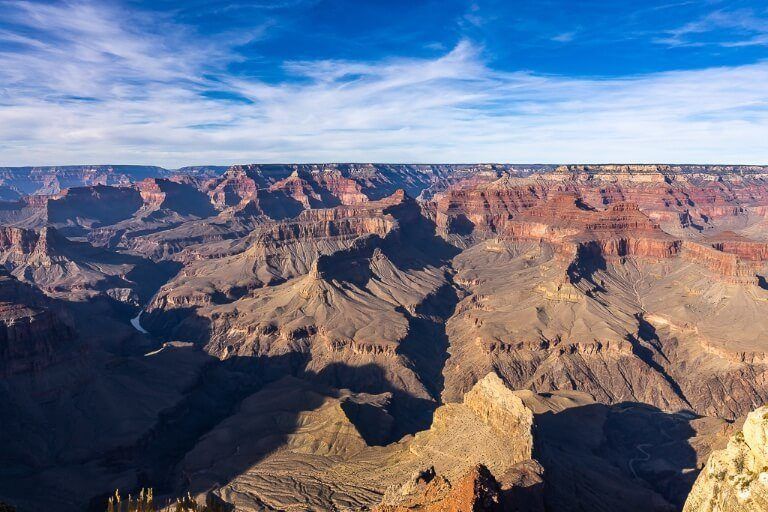
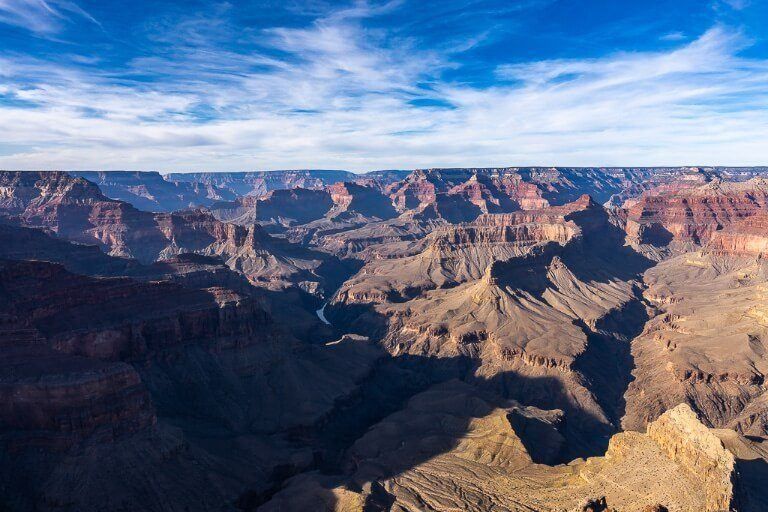
The sun would be to your back as it set so you wouldn’t be able to get any photographs with the sun. However, you would get the best view over the canyon of all the popular spots in the park.
Shadows inside the canyon are already becoming dark and sinister in late afternoon at Pima Point.
2. Mohave Point – Sunset
Walking further East along the Rim from Pima Point you will find Mohave Point.
The walk between Pima and Mohave Point is extremely picturesque as you pass by Monument Creek Vista and The Abyss (pictured below).
As you look at a map, Mohave might look like a better vantage point than Hopi Point with a wider open canyon to the West.
Mohave does have a fantastic vista but it’s the more dramatic canyon view from Hopi making it the more famous and iconic sunset location.
Remember it’s about the canyon and not the direct view at the sun.
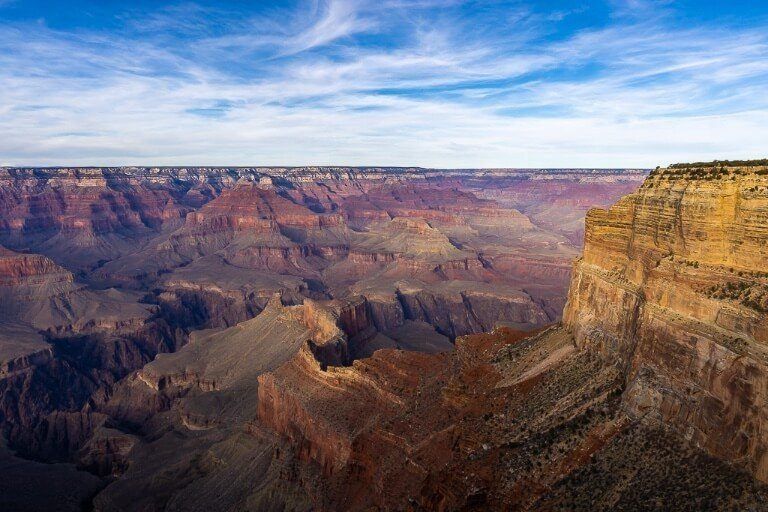
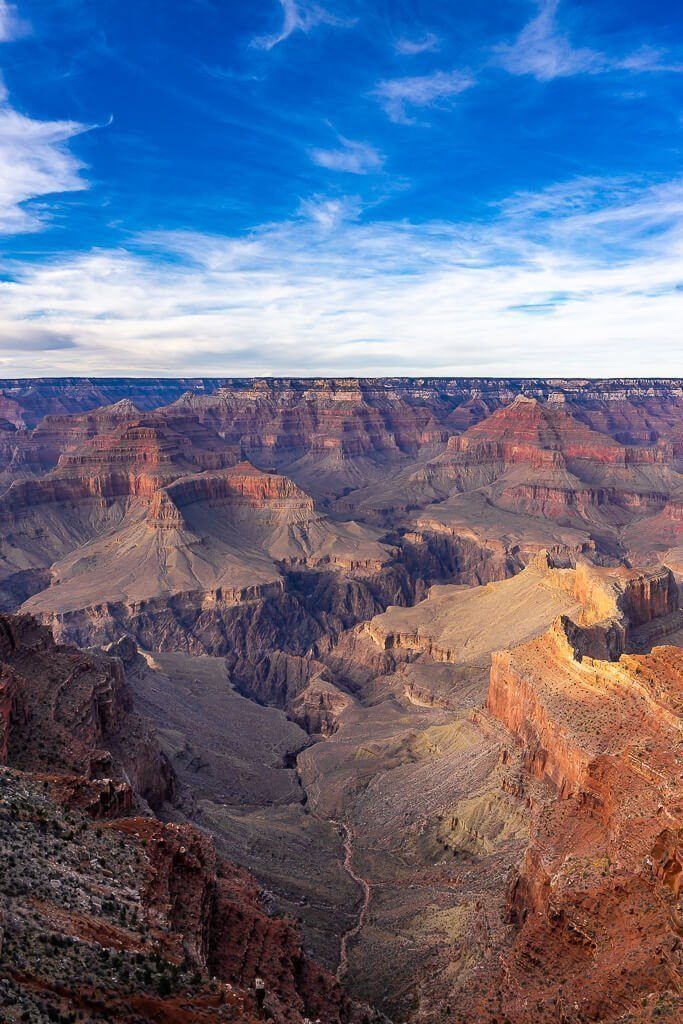
With that said, Mohave is still a fantastic viewpoint to watch the sunset and it will be much quieter than Hopi Point.
If you arrive early enough you can walk Southwest along the Great Mohave Wall to find a secluded spot.
There is a fenced off triangular shaped / pointed overlook with the best view from Mohave Point but it is tight and only a few people will fit in that area.
Personally, we bypassed Mohave and headed straight for the famed Hopi Point sunset.
3. Hopi Point – Sunset
Moving on to ‘the’ Grand Canyon South Rim sunset photography location, Hopi Point.
There’s a reason it is so popular here. Views are extraordinary and you have the perfect angle to see both the sun setting and the canyon transform into a cooling darkening chasm.
The most important thing we can tell you about sunset at Hopi Point is to avoid the actual point itself where the information boards are.
Instead, move either slightly East of the Point for mainly canyon views, or better yet, move Southwest of the Point for sun and canyon views.
Here are a range of photographs we took from sunset at Hopi Point, looking Northeast into the canyon and West at the sun from 30 minutes before sunset to a little after the sun set:
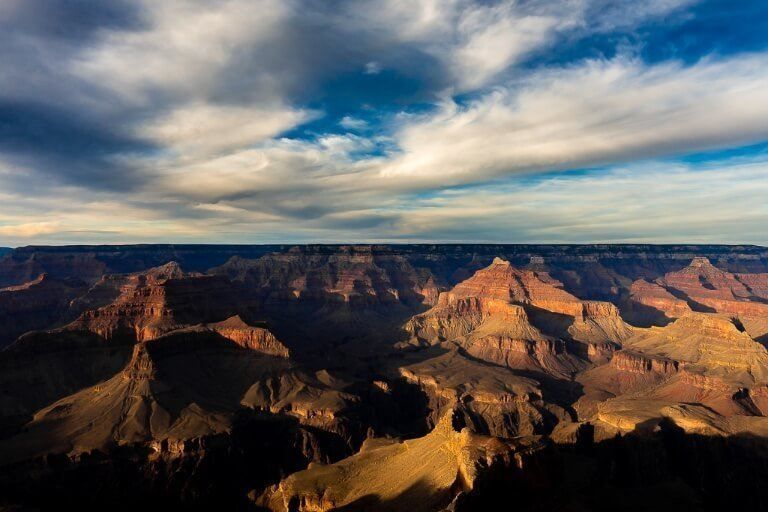
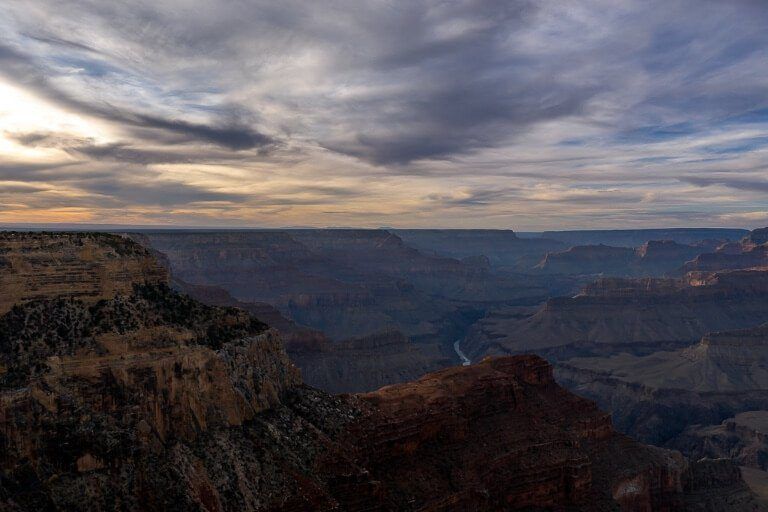
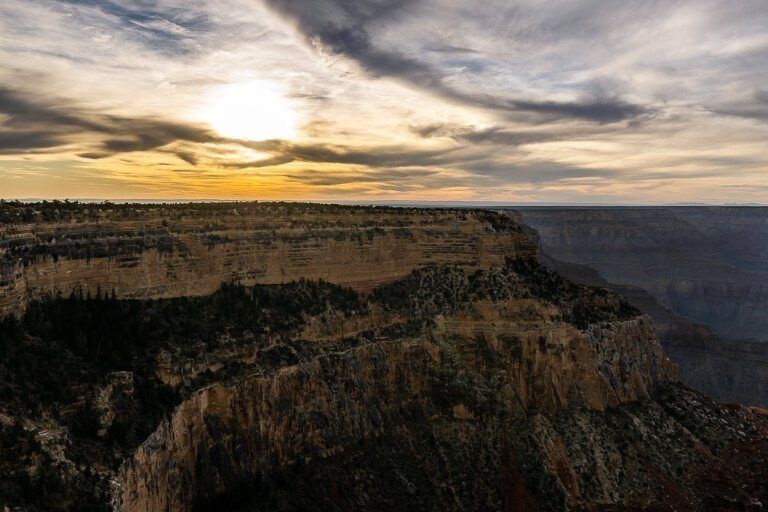
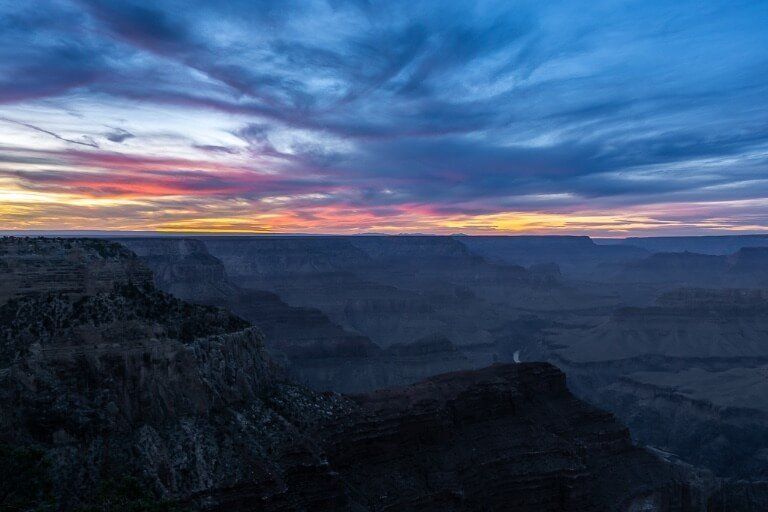
As you can see our sunset was quite a cloudy affair, which meant amazing colors in the sky but no starburst with the sun. We were content with the clouds and colors!
Find a spot along the unguarded cliff edge (very carefully, the drops are significant) and make it yours.
Try to make sure there are no areas on the cliff edge where someone can sit in front of you and arrive early to grab your prime time sunset spot.
4. Yavapai Point – Sunset
Yavapai Point will be extremely busy at sunset because it is the easiest sunset location to access at the Grand Canyon.
You won’t need to take a shuttle to reach the viewpoint, you can drive right into a parking lot a few minutes walk away or simply walk along the Rim from Mather Point and the main visitor center.
Views into the canyon are incredible both at sunrise and sunset from Yavapai Point but the atmosphere is more relaxed for sunset. This is the place to remember your bottle of wine and cheese board!
Our photographs were taken in late afternoon a few hours before sunset:
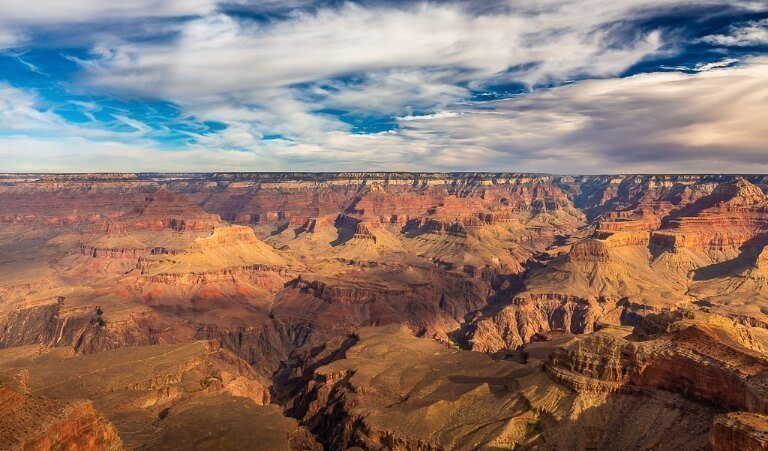
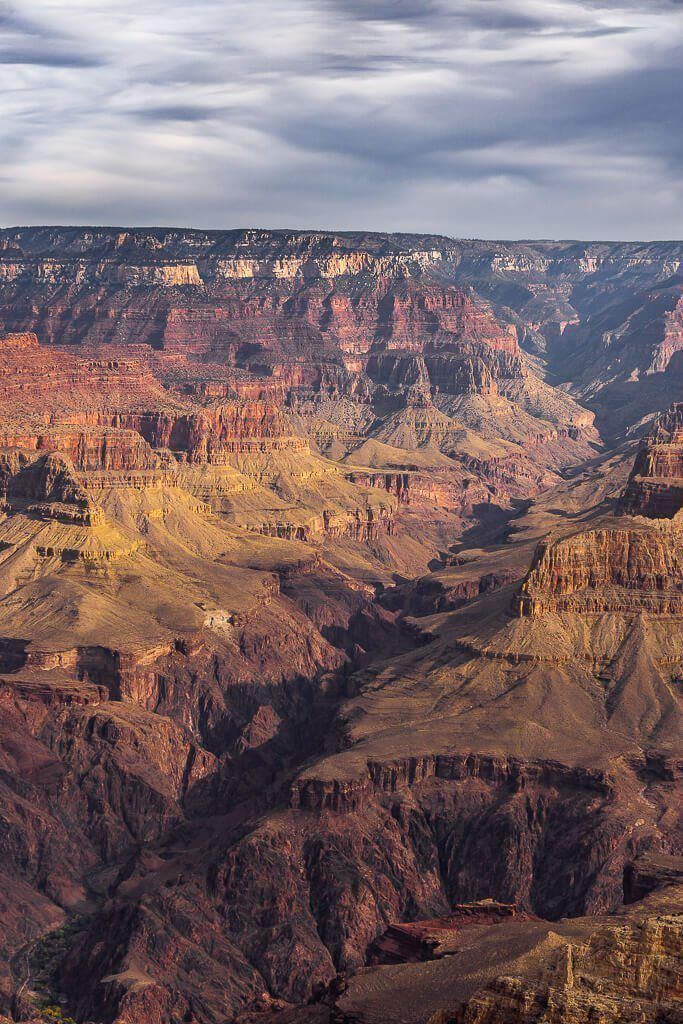
The view is slightly cut off to the West which means at certain times of year you won’t be able to see the sun setting.
However, views into the canyon are amazing and look at the fracture like a tear in the Earth running Northeast as you peer into the canyon.
Fields of View from the Most Popular Grand Canyon Sunrise and Sunset Locations
The diagram below will help you understand the fields of view from each of the sunrise and sunset points we have listed at Grand Canyon South Rim.
Angles of the semi circles shown in the diagram illustrate exact fields of view you have into the canyon from the Rim.
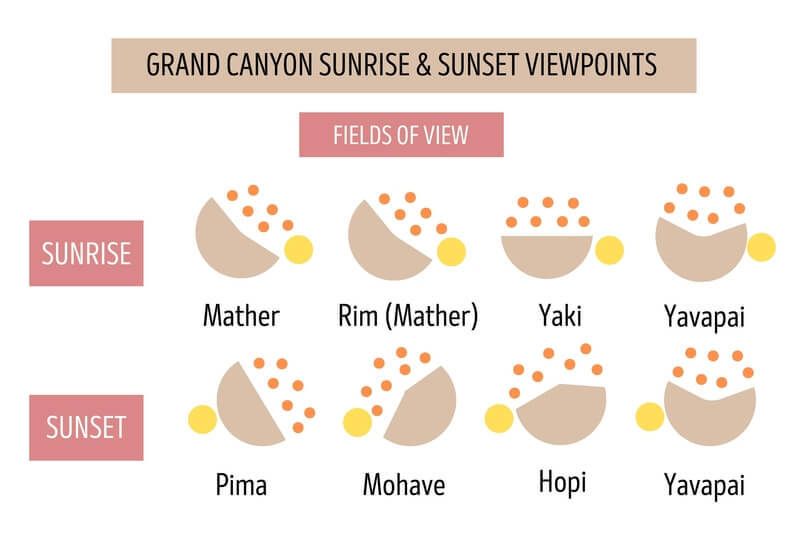
Key:
Brown semi-circles = The Rim
Yellow circles = The Sun
Orange dots = The Canyon
Sunrise vs Sunset – Which is the Better Experience?
This one is up for debate. In terms of the spectacle, opinion will be divided and you will have to see both to make your own decision.
For the adventurous, an early descent into the canyon via South Kaibab Trail or Bright Angel Trail could top trump any of the sunrise viewpoints we have discussed.
Spending a night in the canyon (camping at Bright Angel campground) would give you a unique perspective on both sunrise and sunset at Grand Canyon national park.
Many factors within your control such as ease of access to either sunrise or sunset, the nature of your visit, logistics, timings and early start vs late finish will impact on your preference.
However, there are some things you can’t control that will affect both sunrise and sunset at South Rim:
- Sun – Sun positioning / angle of sunrise and sunset
- Time – Time of day and time of year
- Temperature – How hot or cold it is in the canyon
- Air quality – If the canyon becomes cloudy, misty or hazy
Our Favorite
Personally, we prefer sunrise to sunset at Grand Canyon South Rim.
Both are amazing spectacles, but sunrise feels more authentic and vibrant colors at dawn are out of this world.
We visited Grand Canyon South Rim in November and the cliff edge along Hopi Point where we set up our tripod for sunset felt like we’d been teleported to Times Square in NYC.
We can’t imagine how insanely busy this area would be in July or August.
Aside from the obvious pro of fewer people around at sunrise, we also had a clearer sky with compact clouds. Whereas at sunset, the cloud coverage was thin but widespread and hazy.
Note: Are you visiting nearby Sedona in Arizona before or after South Rim? Here’s our popular roundup of the 15 best sunrise and sunset photography locations in Sedona you can use to plan your photo itinerary.
Planning for Sunrise and Sunset at Grand Canyon South Rim
For both sunrise and sunset at the Grand Canyon, you can access Shuttle buses. Staying nearby either at a campground or hotel will help enormously with logistics for both sunrise and sunset.
Planning for Sunrise
Sunrise can be difficult to organize at the Grand Canyon.
Getting up early is hard enough, but if you don’t book the campground or a nearby hotel early enough, you could be staying 20 minutes to 1 hour drive away.
The good news is that you can drive your car and park at the main visitor center parking lot, which is very close to almost all of the best central sunrise locations.
However, if you want to visit Yaki Point, you will have to take the Orange Route known as Kaibab Rim shuttle. Here’s the National Park Service website for more information about the Kaibab Rim shuttle.
There is an option to park on Desert View Drive and walk to Yaki point but it’s a 1 mile hike, so you’d need to give yourself a further 30 minutes to make it in time.
We recommend you arrive early to get a good spot, particularly between May and September. Do not plan to arrive at sunrise, plan to arrive at the start of civil twilight. Check civil twilight and sunrise times here.
Top-tip: Some of the outcrops along the Rim East of Mather Point extend further out into the canyon than others, try to find one jutting out more prominently.
Planning for Sunset
Sunset is much easier to plan than sunrise. You can easily include sunset into a Grand Canyon day trip itinerary by hiking in the morning in the center / east of the park and making your way over to the Western part of South Rim for sunset.
In Winter months between December 1 and February 28 you can drive your own vehicle along Hermit Road to reach the sunset viewpoints. However, the rest of the year you can only reach the viewpoints by shuttle.
Take the Red Route known as Hermit Road shuttle to reach the best sunset locations of Hopi, Mohave and Lipan points. Here’s the National Park Service website for more information about the Hermit Road shuttle.
We recommend you arrive early to get a good spot, particularly between May and September. Check sunset times here.
Even when we were watching sunset in November, there were people who would sit on the edges of cliffs right in front of our camera. Arriving early is vital if you want a good (and unobstructed!) view.
Top-tip: The second the sun disappears, everyone will rush for the bus. Stay a little longer and you’ll be rewarded with amazing colors in the sky and more room to relax.
Packing Essentials
- Food – Take snacks for sunrise, you will need them.
- Drinks – A lot of water in Summer, plenty of hot coffee / tea any other time of year!
- Headlamps – Tinmiu rechargeable LED hiking headlamps
- Camera and lens – Sony A7R IV with Sony FE 16-35 GM and 24-105 G lenses
- Action camera – GoPro Hero9 Black
- Camera strap – Peak Design Slide
- Tripod – Vanguard Alta Pro 2 Carbon
- Clothes – Wrap up for both sunrise and sunset outside of Summer, it gets very cold.
- Camera gloves – Wooly mittens convertible fingerless
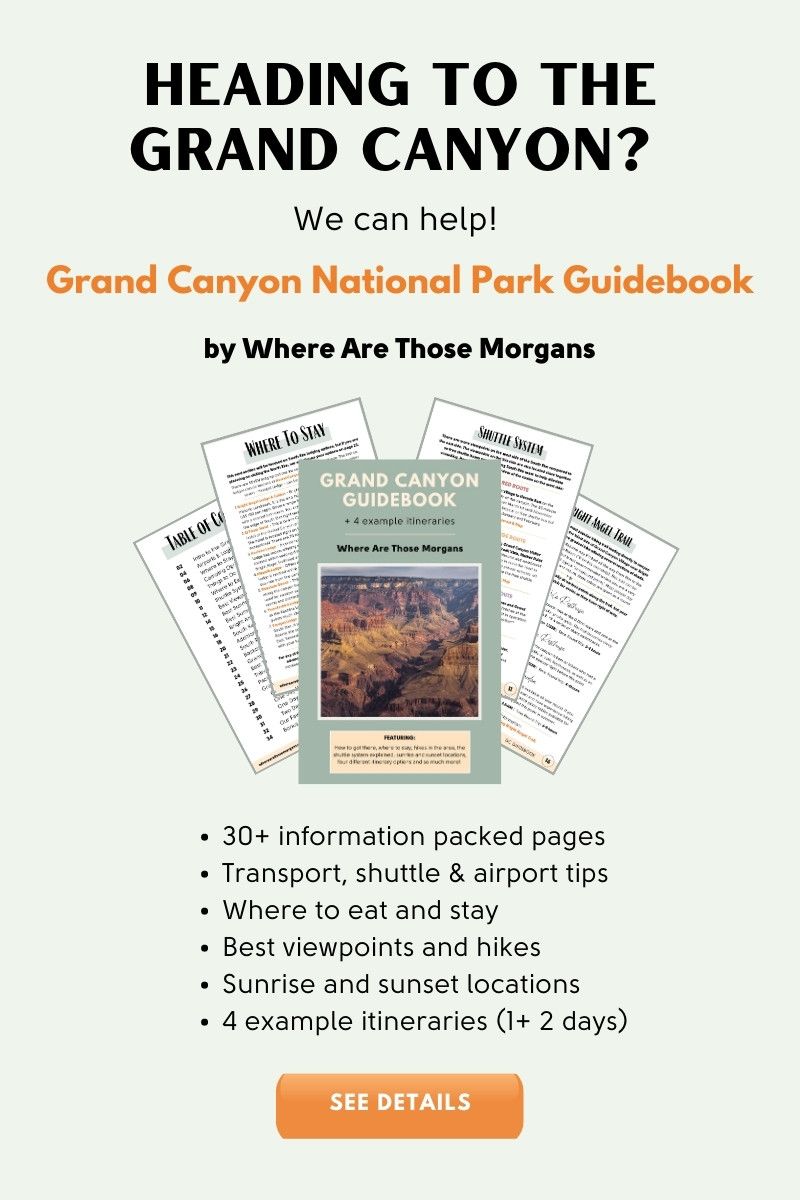
Need Help Planning A Trip To Grand Canyon South Rim?
Grand Canyon is one of the most visited National Parks in the US and it’s a stunning landscape that will genuinely blow you away.
But we also know how important it is to get your trip off to the best possible start by planning in advance.
We have been lucky enough to visit Grand Canyon South Rim twice, at different times of year and with different goals:
- First to sightsee, shoot sunrises and sunsets and see the canyon from every single viewpoint on the Rim.
- Second to day hike Rim to River, South Kaibab to Phantom Ranch to Bright Angel in one day.
If you are planning a trip to Grand Canyon South Rim and want to know:
- Where to stay and eat
- How to get there and use the shuttles
- The best hikes in the area
- Which overlooks to visit
- Where to watch sunrise and sunset
Our 30+ page Grand Canyon South Rim Guidebook with 4 example itineraries will tell you all this information plus more so you can plan the perfect trip to Grand Canyon South Rim National Park.
Our Popular Grand Canyon Guides
- Itinerary – One day Grand Canyon South Rim itinerary
- Best Hikes – 17 Amazing hikes at Grand Canyon National Park
- Hotels – Where to stay and best hotels at Grand Canyon South Rim
- Seasons – Best time of year to visit the Grand Canyon
- Winter – 10 important things about winter at the South Rim
- Viewpoints – Best viewpoints at the Grand Canyon South Rim
- Transport – Airports closest to Grand Canyon National Park
More Arizona Hiking Guides
- Day Hike – South Kaibab to Bright Angel and Phantom Ranch
- South Kaibab – Stops along the South Kaibab Trail
- Bright Angel – Stops along Bright Angel Trail
- Sedona – Amazing hiking trails in Sedona, Arizona
- The Wave – How to hike the Wave in Arizona
- Wave Permit – The best way to win a permit for the Wave
Want more Arizona content? Head over to our Arizona Travel Guides to explore the best of Grand Canyon, Sedona and beyond.
We hope this Grand Canyon sunrise and sunset photography guide helps you plan your visit to the amazing South Rim!
Please let us know if you have any questions about sunrise or sunset photography in the comments below.
Happy Snapping,
Mark and Kristen
Enjoy This Grand Canyon Photography Guide? Pin It For Later!
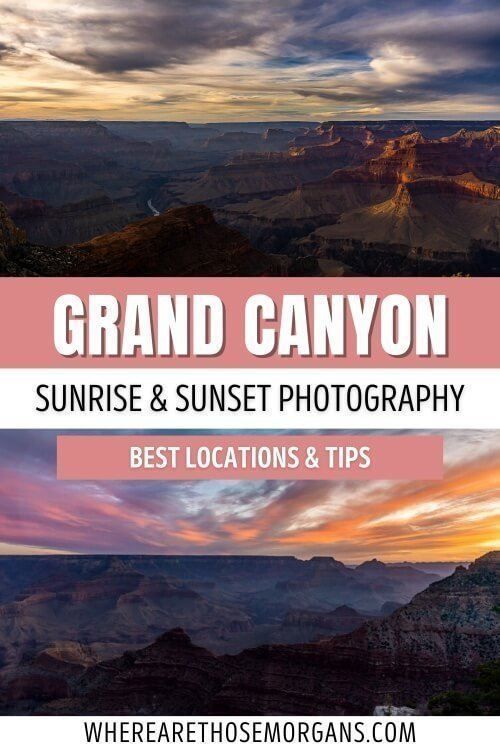
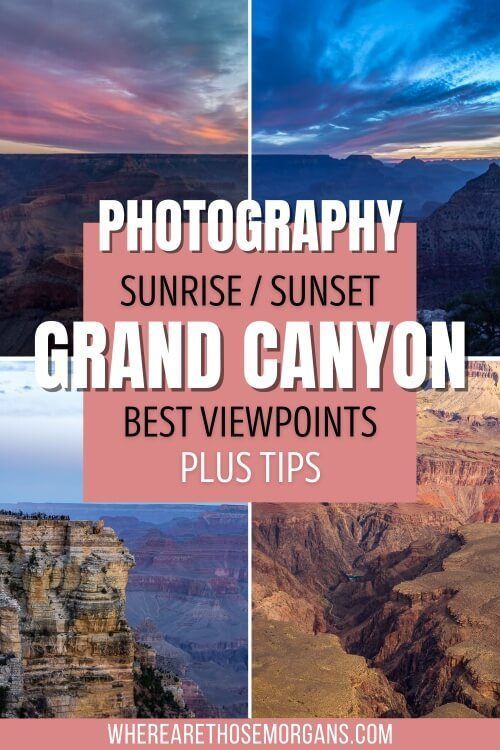
Note: This article contains affiliate links. When you make a purchase using one of these affiliate links, we may earn a small commission at no extra cost to you.
All Rights Reserved © Where Are Those Morgans, LLC. Republishing this article and/or any of its contents (text, photography, maps, graphics, etc.) in whole or in part is strictly prohibited.
Mark and Kristen Morgan are travel, hiking and photography experts. Over the last 6 years traveling full time, they have explored more than 40 countries and 30 US states.
Where Are Those Morgans has been featured in USA Today, Gestalten, Get Your Guide, CityPASS and Condé Nast Traveler along with various other publications. Read more about us.

